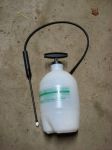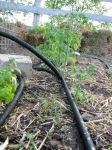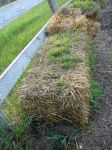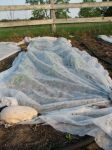Gardening is upon us! Over the last 10 years due to my nearly obsessive quest for efficiency in just about everything, we have evolved a garden that uses resources, (such as water and time) wisely. It also happens to grow plants well despite our short growing season. A few key pieces in our gardening “tool-box” have become essential to this efficiency. First, a disclaimer: I’m writing this on little sleep so I’m aiming for coherency but…
Anyway, 11 things for a great, efficient garden (pictures below text):
1. Soaker Hoses – This one absolutely belongs #1. Soaker hoses put water exactly where you want it, and nowhere else. This is not only an efficient way to water your garden, but it often keeps weeds at bay as well because you are not watering the weeds. We lay them out after we plant the plants -or in the case of seeds, I’ll lay the soaker hoses out first, turn them on for a bit and then plant the seeds next to the hose where the ground is wet. Soaker hoses add both time and water efficiency to a garden.
2. Hose Manifolds – The ideal partner for a soaker-hose watered garden. Manifolds allow you to adjust your garden in “sections” watering each zone as needed with the flip of a few valves. It takes a bit to set it up, but once it’s done, it’s done. This makes the watering process extremely efficient.
3. Kraft Paper – I LOVE craft paper! We use it to mulch our plants we put in the garden as seedlings. We lay the paper out in roles, cut X’s in it, fold the corners back and plant a plant in each open space. We lay the soakers over, (or under) this paper. The ground stays wet and the weeds stay out. You have two choices in buying this: You can buy it as “organic gardening mulch-paper” and pay a premium for it or you can find a home-improvement store and buy “contractors kraft paper” and get twice as much for 1/2 the price. I’ll let you decide. At the end of the season, we till it right into the ground where it adds to the soil for the next year.
4. Frost Covers – These are a necessity where we live. Our growing season can be very, very short and without an early start there are a few crops that may not have time to mature. I’ve also found that frost covers keep the soil nice and moist for germinating small-seeded vegetable like lettuce and carrots. They are helpful in the spring, when the night frosts are not yet over and also helpful in the fall when they may begin again. I’ve also found that they can keep hot-loving plants like peppers a little happier earlier in the season by the slight greenhouse effect the provide.
5. Garden…Claw? – I’m not sure what to call this but it’s great. You can get a small hand version of this or a larger one with a longer handle. This is an absolutely useful tool for “tilling” up weeds and even preparing small beds for planting. Kids think it’s fun too, which means you can trick them into some free labor.
6. Cages/Fence – This is another thing we’ve evolved over the years. Tomatoes need cages. Period. When they are laying on the ground, they aren’t as productive, they are harder to pick and they pick up soil disease way too easily. Since we plant between 60-100 tomato plants a year we tired of buying traditional cages early on, (that break in a season or two). So, we came up with these tomato “tents”. These are made from extremely durable cattle panels, (which can be found at a farm supply store). They are cut in 1/2’s or 1/3’ds and tied together at the top with zip-ties. They’re made to keep cows contained so they have no problem keeping our tomatoes contained year after year after year. You can also use them to grow cucumbers up off the ground, saving ground space. We’re experimenting with that this year.
7. Sprinkler – Well, ok so this one isn’t very original. But, it’s also important. Sometimes there are crops that are watered best with broad-range watering. In our garden this may be our strawberry or lettuce patch. We don’t use it often, but its definitely a necessity.
8. Hand-Waterer – Sometimes you just have to water certain things by hand. Besides, it gives the kids a chance to “give the plants a drink and make them happy”. They like to get involved and this is a great way for them to get a one-on-one connection with the garden.
9. Sprayer – NO! Don’t say a SPRAYER!! Yes, I say a sprayer. Not all sprayers have to perpetuate biological evils. I have two sprayers that are also invaluable tools in my garden. Although our garden is constantly replenished with a good feed of manure every fall, I do like to foliar-feed, (through the leaves) throughout the growing season. It seems to be a bit more efficient for their nutrient metabolism. That’s just my observation. There are a variety of organic products out there for just that -fish emulsion is an example, (although it can smell terrible). My 2nd sprayer I use for a Neem oil spray. This is an oil from a tree in India. It is greatly diluted in water and then sprayed on the plants. It works against biological disease such as bacteria or fungus as well as insects. I use it only when needed, for example if I have a pest problem or if it has been rainy and wet for days and I’m going to have an issue with a fungus or mold.
10. Straw – Good old multi-purpose straw. Now, here is a warning: Don’t use HAY use STRAW. For those who don’t know the difference, hay is the grass from the field, (and all the weeds and weed seeds in it) cut, dried and baled. Straw is the cut, dried and baled stalk left over after a grain harvest -so very few weed seeds. You can get barley straw, oat straw, wheat straw… The bottom line is, straw may grow a bit of the grain it came from but it’s easy to pull. Hay will grow all kinds of weeds that will encourage a hostile take-over of your garden.
We use straw for two main purposes. First, we build our cold-frames with them so plants can get an earlier start. 2nd, when the cold frames are no longer needed, we take the straw and use it for mulch under our vines. At the end of the season it returns to the soil and improves the garden for next year.
11. Old Storm Doors – We pretty much only use these for cold-frames. However, cold-frames are an important part of our early-season gardening. Old double-paned windows will work as well.
There you have it, 11 things for a great, efficient garden. I hope it was coherent, but I can make no promises because I’m not sure I’m actually awake right now. Pictures below…
- A not-so-evil sprayer
- Soaker hoses
- An old storm door
- A hose manifold for zone-watering
- The “claw” tool
- Tomatoes in cages
- Sprinkler
- Cozy peppers under a frost cover
- Straw, (not hay) -see the oat grass growing?
- A BIG roll of kraft paper
- Carrot seedlings under a frost cover
- Hand-watering himself and the peas











